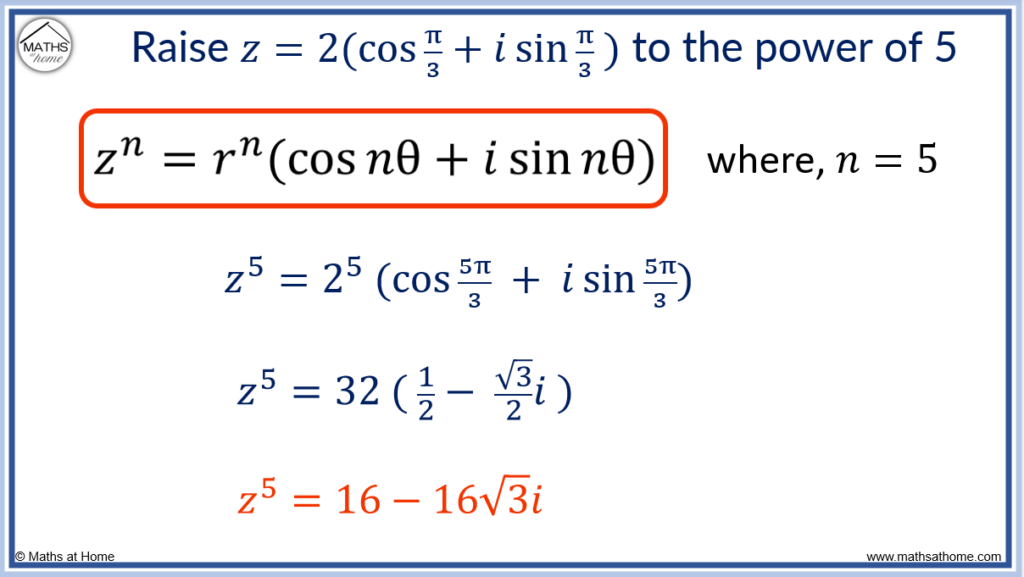Video Lesson: How to Use De Moivre’s Theorem to Find Powers of Complex Numbers
What is De Moivre’s Theorem?
De Moivre’s theorem is a formula used for finding powers of complex numbers. De Moivre’s theorem states that for any complex number z = r( cos(θ) + isin(θ) ), powers of this number can be calculated using zn = rn( cos(nθ) + isin(nθ) ).
To raise a complex number to a power simply raise the modulus (r) to the same power (n) and also multiply the argument (θ) by the power (n).

De Moivre’s theorem (pronounced ‘duh mwa vruh’) provides a general equation which can be used to raise a complex number to a higher power in a much more efficient manner than via manual algebraic calculation. This is particularly true when evaluating larger powers.
In the same manner, it is used to find nth roots of complex numbers by raising the complex number to a rational power.
De Moivre’s theorem has practical applications in various fields such as engineering, physics, and mathematics.
For any complex number,
:
De Moivre’s theorem for raising a complex number to a power
De Moivre’s theorem can be used with positive, negative or rational powers.
How to Raise Complex Numbers to a Power Using De Moivre’s Theorem
To raise a complex number, z = r(cosθ + isinθ) to the power of n, use the formula zn = rn(cos(nθ) + isin(nθ)).
For example, 2(cos(π/3)+isin(π/3) to the power of 5 is given by 25(cos(5π/3)+isin(5π/3)). This can be evaluated and simplified as 16-16√3.
In the example of raising to the power of 5:
- n = 5
- r = 2
-

Using De Moivre’s theorem:
The value can be substituted in to obtain or
.
Therefore becomes
which simplifies to
.
To raise a complex number in the form z=a+bi to the power of n, first write the complex number in the form z = r(cos nθ + isin nθ) where r = √(a2 + b2) and θ is the argument.
Then use the formula zn = rn(cos(nθ) + isin(nθ)).
To raise a complex number in the form z=a+bi to the power of n:
- Calculate the modulus (r) and argument (θ).
- Write the complex number in the form z=r(cosθ+isinθ).
- Raise the complex number to the power of n using zn=rn(cos(nθ)+isin(nθ)).
- Simplify the expression.
For example, find the exact value of .
Step 1. Calculate the modulus (r) and argument (θ)
The modulus of a complex number is calculated using , , where a and b are the size of the real and imaginary parts of the complex number respectively in the form
.
Therefore in :
Substituting these into the modulus equation, and therefore,
.
and so,
.
The argument is shown in the diagram below as the angle between the complex number and the positive real axis on the complex plane.
Using trigonometry, and so,
.

Step 2. Write the complex number in the form z=r(cosθ+isinθ)
Using:
is written as
Step 3. Raise the complex number to the power of n using zn=rn(cos(nθ)+isin(nθ))
To raise to the power of 6, we use De Moivre’s theorem
Where:
(n is the power we are raising the complex number to)
Therefore .
And so, becomes
Step 4. Simplify the expression
Since:
becomes
or
.
Expanding this, .

Find the exact value of .
For the complex number
Step 1. Calculate the modulus (r) and argument (θ)
For the complex number, :
The modulus is given by: and so,
.
The argument is given by and so
which can be evaluated to obtain
.
Step 2. Write the complex number in the form z=r(cosθ+isinθ)
Using:
can be written as
.
Step 3. Raise the complex number to the power of n using zn=rn(cos(nθ)+isin(nθ))
In the case of finding , n = 4.
Therefore .
Therefore becomes
.
Step 4. Simplify the expression
Therefore simplifies to
.
Expanding this, .

How to Use De Moivre’s Theorem to Raise a Complex Number to a Negative Power
De Moivre’s theorem zn = rn(cos(nθ) + isin(nθ)) can be used to raise a complex number to a negative power. In this case, the value of n will be negative.
For example, find the exact value of .
In the form , the complex number
has a value of a=-1 and b=-1.
Therefore becomes
and so,
and
.
The complex number is in the third quadrant of the complex plane and so, the argument is negative. It is measured clockwise from the positive real axis with an angle of .
The value of n is equal to the value of the power that the complex number in the question has been raised to. That is, n = -2.
Therefore becomes
or
.
Since:
and so,
.

How to Find the Roots of a Complex Number
The nth roots of a complex number z=r(cosθ+isinθ) are calculated using the formula n√z = (n√r) ( cos(θ/n + 2πk/n) + i sincos(θ/n + 2πk/n) ).
De Moivre’s theorem is used with a rational power of so that the formula for the nth root of a complex number is:
Where:
- n is the nth root required
- r is the modulus of the complex number
- θ is the argument of the complex number
- k takes values from 0 to (n-1)

For example, calculate the cube roots of .
In this example:
- n = 3 (since we are finding the cube root)
- r = 8
- k = 0, 1 and 2 (since n = 3 and we use values of k up to n-1)
Substituting these values into we obtain:
This simplifies to:
or
.
We now substitute in values of k=0, k=1 and k=2 to obtain the three cube roots.
For k=0: we obtain
and so,
For k=1: we obtain
.
Adding the fractions to simplify we obtain:
For k=2: we obtain
or
.
Adding the fractions:

